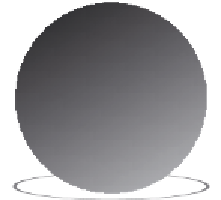Global Positioning System Reference
In-Depth Information
FIGURE 4.7.
Lambert's cylindrical equal area projection. (a) Wrap a cylinder around
the globe, and cut the globe with a plane, passing through the north-south axis. The
plane will intersect the globe along meridians (great circles), and the cylinder along
straight lines, as shown. This is how longitude is projected. (b) Cut the globe hori-
zontally with a plane. The plane will intersect the globe along parallels (lines of con-
stant latitude), and the cylinder on circles, as shown. This is how latitude is projected.
(c) The unfolded cylinder yields a flat map. Toward the poles, the parallels get closer
together. (The opposite occurs for the Mercator projection.)
FIGURE 4.8.
World map derived from a Lambert cylindrical equal area projection.
This map looks very squashed, especially near the poles. Its one saving grace is
that it preserves areas, though shapes can be horribly distorted.
NASA image.











































